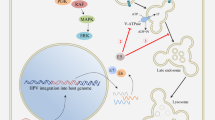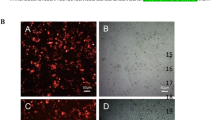Abstract
Although gene therapies using tissue-specific promoters have been reported to be a promising tool for treating cancers, few studies have explored this possibility for uterine cervical cancer. MN/CA9 is a transmembrane glycoprotein that was first identified in the human cervical carcinoma cell line, HeLa. Since MN/CA9 protein is highly expressed in uterine cervical cancer tissues, but not in normal cervix, we constructed a tumor-specific replication-competent adenoviral vector utilizing MN/CA9 promoter (Ad-MN/CA9-E1a), which can replicate only in MN/CA9-expressing cells. Infection of Ad-MN/CA9-E1a to MN/CA9-positive uterine cervical cancer cells (HeLa, C-33 A and SiHa) resulted in much stronger Ad5 E1a protein expressions compared with MN/CA9-negative cells (SK-RC-29), suggesting a tissue-specific replication of this recombinant adenovirus. In vitro cytotoxicity assay revealed that the growth of MN/CA9-positive cells was significantly inhibited with 0.01–1 MOI of Ad-MN/CA9-E1a, but the growth of MN/CA9-negative cells (SK-RC-29) could only be inhibited by as many as 100 MOI. Intratumoral injection of Ad-MN/CA9-E1a effectively induced growth delay of HeLa tumors in nude mice. These results suggest that a novel replication-competent adenoviral vector mediated by MN/CA9 promoter, Ad-MN/CA9-E1a, can selectively replicate in MN/CA9-expressing tumors with cytotoxic effects and may be utilized for the treatment of uterine cervical cancer.
This is a preview of subscription content, access via your institution
Access options
Subscribe to this journal
Receive 12 print issues and online access
$259.00 per year
only $21.58 per issue
Buy this article
- Purchase on Springer Link
- Instant access to full article PDF
Prices may be subject to local taxes which are calculated during checkout






Similar content being viewed by others
References
Greenlee RT, Murray T, Bolden S, et al. Cancer statistics, 2000. CA Cancer J Clin. 2000;50:7–33.
Parkin DM, Pisani P, Ferlay J . Estimates of the worldwide incidence of 25 major cancers in 1990. Int J Cancer. 1999;80:827–841.
Orr Jr JW, Shingleton HM, Hatch KD, et al. Correlation of perioperative morbidity and conization to radical hysterectomy interval. Obstet Gynecol. 1982;59:726–731.
Forney JP . The effect of radical hysterectomy on bladder physiology. Am J Obstet Gynecol. 1980;138:374–382.
Ralph G, Tamussino K, Lichtenegger W . Urological complications after radical hysterectomy with or without radiotherapy for cervical cancer. Arch Gynecol Obstet. 1990;248:61–65.
Nguyen HN, Nordqvist SR . Chemotherapy of advanced and recurrent cervical carcinoma. Semin Surg Oncol. 1999;16:247–250.
Omura GA . Chemotherapy for stage IVB or recurrent cancer of the uterine cervix. J Natl Cancer Inst Monogr. 1996;21:123–126.
Der CJ, Stanbridge EJ . A tumor-specific membrane phosphoprotein marker in human cell hybrids. Cell. 1981;26:429–438.
Opavsky R, Pastorekova S, Zelnik V, et al. Human MN/CA9 gene, a novel member of the carbonic anhydrase family: structure and exon to protein domain relationships. Genomics. 1996;33:480–487.
Pastorek J, Pastorekova S, Callebaut I, et al. Cloning and characterization of MN, a human tumor-associated protein with a domain homologous to carbonic anhydrase and a putative helix-loop-helix DNA binding segment. Oncogene. 1994;9:2877–2888.
Liao SY, Brewer C, Zavada J, et al. Identification of the MN antigen as a diagnostic biomarker of cervical intraepithelial squamous and glandular neoplasia and cervical carcinomas. Am J Pathol. 1994;145:598–609.
Liao SY, Stanbridge EJ . Expression of MN/CA9 protein in Papanicolaou smears containing atypical glandular cells of undetermined significance is a diagnostic biomarker of cervical dysplasia and neoplasia. Cancer. 2000;88:1108–1121.
McKiernan JM, Buttyan R, Bander NH, et al. Expression of the tumor-associated gene MN: a potential biomarker for human renal cell carcinoma. Cancer Res. 1997;57:2362–2365.
Uemura H, Nakagawa Y, Yoshida K, et al. MN/CA IX/G250 as a potential target for immunotherapy of renal cell carcinomas. Br J Cancer. 1999;81:741–746.
Turner JR, Odze RD, Crum CP, et al. MN antigen expression in normal, preneoplastic, and neoplastic esophagus: a clinicopathological study of a new cancer-associated biomarker. Hum Pathol. 1997;28:740–744.
Vermylen P, Roufosse C, Burny A, et al. Carbonic anhydrase IX antigen differentiates between preneoplastic malignant lesions in non-small cell lung carcinoma. Eur Respir J. 1999;14:806–811.
Saarnio J, Parkkila S, Parkkila AK, et al. Immunohistochemical study of colorectal tumors for expression of a novel transmembrane carbonic anhydrase, MN/CA IX, with potential value as a marker of cell proliferation. Am J Pathol. 1998;153:279–285.
Bartosova M, Parkkila S, Pohlodek K, et al. Expression of carbonic anhydrase IX in breast is associated with malignant tissues and is related to overexpression of c-erbB2. J Pathol. 2002;197:314–321.
Vile RG, Russell SJ, Lemoine NR . Cancer gene therapy: hard lessons and new courses. Gene Ther. 2000;7:2–8.
Zhang WW . Development and application of adenoviral vectors for gene therapy of cancer. Cancer Gene Ther. 1999;6:113–138.
Zhang L, Akbulut H, Tang Y, et al. Adenoviral vectors with E1A regulated by tumor-specific promoters are selectively cytolytic for breast cancer and melanoma. Mol Ther. 2002;6:386–393.
Kirn D . Replication-selective oncolytic adenoviruses: virotherapy aimed at genetic targets in cancer. Oncogene. 2000;19:6660–6669.
Ebert T, Bander NH, Finstad CL, et al. Establishment and characterization of human renal cancer and normal kidney cell lines. Cancer Res. 1990;50:5531–5536.
Fallaux FJ, Kranenburg O, Cramer SJ, et al. Characterization of 911: a new helper cell line for the titration and propagation of early region 1-deleted adenoviral vectors. Hum Gene Ther. 1996;7:215–222.
Fallaux FJ, Bout A, van der Velde I, et al. New helper cells and matched early region 1-deleted adenovirus vectors prevent generation of replication-competent adenoviruses. Hum Gene Ther. 1998;9:1909–1917.
Bett AJ, Haddara W, Prevec L, et al. An efficient and flexible system for construction of adenovirus vectors with insertions or deletions in early regions 1 and 3. Proc Natl Acad Sci USA. 1994;91:8802–8806.
Zhang WW, Fang X, Branch CD, et al. Generation and identification of recombinant adenovirus by liposome-mediated transfection and PCR analysis. Biotechniques. 1993;15:868–872.
Ko SC, Cheon J, Kao C, et al. Osteocalcin promoter-based toxic gene therapy for the treatment of osteosarcoma in experimental models. Cancer Res. 1996;56:4614–4619.
Rodriguez R, Schuur ER, Lim HY, et al. Prostate attenuated replication competent adenovirus (ARCA) CN706: a selective cytotoxic for prostate-specific antigen-positive prostate cancer cells. Cancer Res. 1997;57:2559–2563.
Hallenbeck PL, Chang YN, Hay C, et al. A novel tumor-specific replication-restricted adenoviral vector for gene therapy of hepatocellular carcinoma. Hum Gene Ther. 1999;10:1721–1733.
Loncaster JA, Harris AL, Davidson SE, et al. Carbonic anhydrase (CA IX) expression, a potential new intrinsic marker of hypoxia: correlations with tumor oxygen measurements and prognosis in locally advanced carcinoma of the cervix. Cancer Res. 2001;61:6394–6399.
Stanbridge EJ, Der CJ, Doersen CJ, et al. Human cell hybrids: analysis of transformation and tumorigenicity. Science. 1982;215:252–259.
Pastorekova S, Zavadova Z, Kostal M, et al. A novel quasi-viral agent, MaTu, is a two-component system. Virology. 1992;187:620–626.
Zavada J, Zavadova Z, Pastorekova S, et al. Expression of MaTu-MN protein in human tumor cultures and in clinical specimens. Int J Cancer. 1993;54:268–274.
Graham FL, Smiley J, Russell WC, et al. Characteristics of a human cell line transformed by DNA from human adenovirus type 5. J Gen Virol. 1977;36:59–72.
Shirakawa T, Gardner TA, Ko SC, et al. Cytotoxicity of adenoviral-mediated cytosine deaminase plus 5-fluorocytosine gene therapy is superior to thymidine kinase plus acyclovir in a human renal cell carcinoma model. J Urol. 1999;162:949–954.
Acknowledgements
We thank Dr Hee Jae Joo, Department of Pathology, for assistance in the preparation and interpretation of histologic studies. This work was supported by 2001 grant from the Department of Medical Sciences, The Graduate School, Ajou University.
Author information
Authors and Affiliations
Corresponding author
Rights and permissions
About this article
Cite this article
Lim, H., Ahn, M., Chung, H. et al. Tumor-specific gene therapy for uterine cervical cancer using MN/CA9-directed replication-competent adenovirus. Cancer Gene Ther 11, 532–538 (2004). https://doi.org/10.1038/sj.cgt.7700732
Received:
Published:
Issue Date:
DOI: https://doi.org/10.1038/sj.cgt.7700732
Keywords
This article is cited by
-
Gynecologic oncology group trials of chemotherapy for metastatic and recurrent cervical cancer
Current Oncology Reports (2005)



